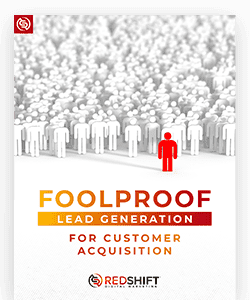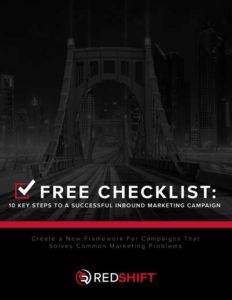INBOUND MARKETING AGENCY IN PITTSBURGH PA
What is Inbound Marketing?
“Inbound” is a term that’s frequently used but not always clearly defined or explained. In a broad sense, an inbound marketing strategy draws customers in using techniques such as creating helpful content for a targeted audience, interacting with customers on social platforms, and optimizing websites for search engines. This differs from traditional outbound marketing, which reaches out to customers through untargeted traditional advertising methods, cold calling, and direct mail.
Schedule a
FREE CALL WITH US
Inbound Marketing Methodology
Attracting Strangers
First, you need to attract strangers to the hub of your online assets – your website. To turn strangers into visitors, we use blogging, social media posting and search engine optimization.
Closing Prospects
Once we’ve collected an email address from your prospect, we convert them into a customer through lead nurturing. To nurture your leads into customers, we use email marketing and marketing automation workflows.
Converting Visitors
First, you need to attract strangers to the hub of your online assets – your website. To turn strangers into visitors, we use blogging, social media posting and search engine optimization.
Delighting Customers
The journey doesn’t end once we’ve landed the customer. Your satisfied customers are your best promoters, so it’s important that we continue to delight them and provide them with relevant content.
Why Inbound Marketing
Your phone rings, and an unfamiliar number is on the screen.
What’s your first thought?
“Probably a Robocall”.
The truth is consumers have wised up. Outbound, in-your-face marketing methods don’t work anymore. We see them coming, recognize them, and are immune to them.
Today, we know how to use the internet to research buying decisions, so we can confidently make the right choice.
Inbound marketing guides the customer through this research process and educates them. It’s a subtle sales strategy, but it’s highly effective.
Top Benefits of Inbound Marketing
You can track analytics for all of your major inbound goals such as web traffic, conversions, email open rates, social media engagement and more. This is another reason inbound marketing is cost effective, as tracking data lets you fine-tune your efforts and improve your results.
Inbound marketing is often more effective than traditional advertising for building trust and credibility. When you create informative blog posts, social media posts, videos or other content, you display your knowledge and expertise. Over time, this creation of authority can build your brand as a go-to resource in the industry.
Businesses can enjoy solid ROI and an enhanced reputation with inbound marketing. At the same time, inbound isn’t always a stand-alone strategy. There’s still a place for outbound marketing, especially when combined with inbound techniques.
Campaigns that are focused on a targeted audience rather than the masses are typically less expensive. Essentially, you’re not paying to put your ad in front of just anyone — you don’t have to reach everyone, only your selected audience.
Many people quickly grow tired of traditional advertising. Some even use technology such as ad blockers to avoid them. Statista reports that in 2019, roughly 25.8 percent of internet users were blocking advertising on their connected devices, with that figure expected to grow. With inbound marketing, you aim to provide the right information to the right people to feel less like an interruption.
-
Inbound Marketing is
Highly Targeted - Inbound Marketing Has Measurable Results
- Inbound Marketing Builds Authority
- Inbound Marketing is Cost-Effective
- Inbound Marketing is Not Intrusive
Creating Your Inbound Marketing Strategy
Steps for Forming an Effective Inbound Marketing Strategy for Your Business:
SETTING GOALS
Be Clear About Your Objectives
It helps to be clear about your objectives for inbound marketing. Justifying your marketing plans and budget is an ongoing process. Once you get the green light to move forward, managers will expect regular reports on your progress. Recommendations of objectives for your inbound marketing plan may include:
Inbound tactics can be extremely effective for building a mailing list of potential clients or for enticing people to reach out regarding your product or service. For example, you can entice people to complete an opt-in form on a webpage using a strong call to action (CTA) by offering a download or a discount. When asking for personal information from potential clients like an email or general contact information, it’s important to create easy-to-use forms and to offer transparency regarding your intended use, i.e. will you be sending them promotional emails or signing them up for a newsletter?
While inbound techniques are more about providing information and cultivating relationships than directly selling, they can motivate customers to visit your sales or product pages. Streamlining your website or creating new landing pages may lead to more users making their way to the “check-out” page on your website. If your metric is set at a certain sales goal, there are several tactics that can lead you there. What is important is the ability to identify the successful tactics and weed out the ineffective ones.
Inbound marketing is especially good for spreading the word and controlling the narrative about your brand. You can do this by creating strong content, generating traffic to your web pages through paid ads and engaging with customers on social media. Growing brand awareness should be a continuous effort, as increased engagement, authenticity and recognition are soon to follow.
For marketing campaigns to proceed smoothly, it has to be clear who will do what. Whether it’s one person or a dedicated team, make sure everyone is clear about his or her tasks.
Knowing your audience is one of the most vital factors in determining your marketing efforts. As we already noted, precise targeting is one of the main advantages of inbound marketing. Yet to do this effectively, you must first have a clear idea of who you’re targeting. There are a few essential points to clarify about your audience.
We’d recommend starting off by creating a buyer persona. A buyer persona is a fictional yet useful representation of your “typical” customer. You want to understand who your customers are, what problems they face and what solutions are most appealing to them. You can gather this information by doing some demographic research. You might find, for example, that a beauty product you are marketing is most likely to appeal to suburban women between the ages of 35-55 who have an annual income of at least $50,000. You can gather more specific information by engaging with your customers and followers on social media, or holding in person peer groups. You might also conduct polls or ask questions on your blog. The bottom line is — talk to your customers to learn as much as you can!
It’s also possible for some businesses to have multiple buyer personas. An airline, for example, is likely to have several types of customers such as business and leisure travelers. They will launch different campaigns for each type of customer.
When researching your audience, you’ll want to learn where they spend their time online. Which social media platforms do they use most frequently? You can take an educated guess about this based on demographic research. While there are some general principles (for example, a majority of Pinterest users are women), you always have to test your results on various platforms. You can also gain this type of information by observing your competition.
Whether you need a budget to hire more help, to purchase services or software or to hire an agency, it’s often necessary to convince managers or your CEO that inbound marketing is a worthwhile investment. Senior management is focused on the bottom line, but you can start by explaining some leading benefits of inbound marketing. Here are some tips to consider:
Align your strategy with the company’s goals. Explain that inbound marketing tactics can help you obtain more leads and customers. Recite accurate numbers that support your claim. For example, DemandMetric reports that content marketing generates three times as many leads as outbound marketing while costing 62% less.
Create forecasts of projected results. For each goal, compile a projection on the results you expect to achieve. You might forecast how many additional website visitors you expect to get through SEO or how many leads you expect to gain with email marketing.
Use case studies. Case studies are one of the best tools to argue your case. Find examples of companies in your industry that have seen impressive results from inbound marketing. It’s also helpful if you can point to companies using the specific strategies you’re pitching. For example, if you want to launch an influencer marketing campaign, look for case studies that back your claims.
Analyze the competition. If you can show that your competitors are getting solid results from inbound marketing, this will be a powerful incentive for senior managers to get on board. No one wants to be left behind.

Measure Your Results
If you want your inbound marketing efforts to yield success, you must track your results (after you have already determined your goals, as stated earlier). Analytics is a crucial aspect of content, email, and social media marketing. Fortunately, there are many effective tools for tracking your inbound campaigns.
Google Analytics is a powerful free tool that lets you track useful website metrics. Social media sites all have built-in analytics. Facebook Insights lets you track not only your own stats but those of any Facebook page, which is great for monitoring the competition.
Certain metrics look impressive at first glance, but don’t necessarily translate into tangible results. That’s why clicks, impressions and social media likes or shares are sometimes called vanity metrics. This doesn’t mean these numbers have no value. They are easy to track and can help you gauge interest in your content. However, you should recognize the limitations of vanity metrics and understand that your managers are more concerned with sales qualified leads (SQL), cost-per-lead (CPL) and customer acquisition cost (CAC).
Some analytics tools let you “spy” on your competitors. As noted, Facebook Insights lets you do this with Facebook pages. You can also find your competitors’ SEO (e.g. top keywords), website traffic, backlinks and paid campaigns.
CONTINUE TO EVOLVE YOUR
Inbound Marketing Strategy
Successful Inbound Marketing Strategies need to evolve.
- Don’t get overly attached to a certain platform or tactic. What works today might not work next month, and vice versa. It’s worthwhile to periodically revisit older approaches and test new ones.
- Consistency is one of the most important factors for all types of inbound marketing. Stick to your schedule for posting content, sending emails, and other methods. The more consistent you are, the easier it is to build authority and a loyal following.
- Inbound techniques work best when combined. Just about every inbound tactic we’ve covered works best as part of a holistic strategy. Strong content helps you rank better in search engines. More traffic to your blog and social media sites helps you grow your email list.
- Inbound marketing takes time, and the results are cumulative. As you publish more content, your website will start to rank better. More engagement on social media means more followers and shares. A growing email list helps you generate more leads and sales. One way to jumpstart your results is to combine inbound and outbound techniques. You might, for example, send traffic to your digital properties with offline advertising. Paid digital campaigns can also help you see faster results.
Implementing a successful inbound marketing strategy sounds like a tall order. But don’t worry — you don’t have to tackle it alone. RedShift provides customized inbound marketing services to help you communicate the uniqueness of your brand and find more leads and customers.
LET'S MEET VIRTUALLY
TIME TO SHIFT?
You don’t have to tackle inbound alone.
Let our team of experts craft a plan to communicate the uniqueness of your brand.

